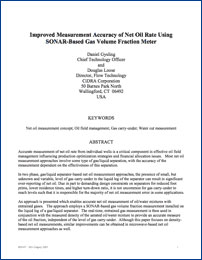2005 ISA Calgary • Improved Measurement Accuracy of Net Oil Rate
Improved Measurement Accuracy of Net Oil Rate Using SONAR-Based Gas Volume Fraction Meter
Accurate measurement of net oil rate from individual wells is a critical component in effective oil field management influencing production optimization strategies and financial allocation issues. Most net oil measurement approaches involve some type of gas/liquid separation, with the accuracy of the measurement dependent on the effectiveness of this separation.
In two phase, gas/liquid separator-based net oil measurement approaches, the presence of small, but unknown and variable, level of gas carry-under in the liquid leg of the separator can result in significant over-reporting of net oil. Due in part to demanding design constraints on separators for reduced foot prints, lower residence times, and higher turn-down ratio, it is not uncommon for gas carry-under to reach levels such that it is responsible for the majority of net oil measurement error in some applications.
An approach is presented which enables accurate net oil measurement of oil/water mixtures with entrained gases. The approach employs a SONAR-based gas volume fraction measurement installed on the liquid leg of a gas/liquid separator. The real-time, entrained gas measurement is then used in conjunction with the measured density of the aerated oil/water mixture to provide an accurate measure of the oil fraction, independent of the level of gas carry-under. Although this paper focuses on density- based net oil measurements, similar improvements can be obtained in microwave-based net oil measurement approaches as well.
Laboratory results are presented which demonstrate the ability of the combination U-tube coriolis meter and a SONAR-based gas volume fraction meter to accurately report the density of the liquid phase of gas/liquid mixture with varying levels of gas volume fraction.
Data from a field trial of this approach on a producing oil well is also presented. The data show the presence of small, but varying, levels of entrained gases in the liquid leg of a Gas Liquid Cylindrical
Cyclone separator in the range of 0% to 5% by volume, which, if not appropriately considered in the net oil measurement, would result in ~100% over reporting of net oil over a 9-1/2 hour well test.

